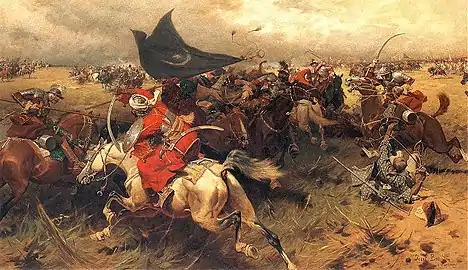| Battle of Lwów | |||||||
|---|---|---|---|---|---|---|---|
| Part of the Polish–Ottoman War (1672–76) | |||||||
 Battle over the Ottoman banner by Józef Brandt | |||||||
| |||||||
| Belligerents | |||||||
|
|
| ||||||
| Commanders and leaders | |||||||
| Ibrahim Shishman | John III Sobieski | ||||||
| Strength | |||||||
| 20,000[1]: 653 | ~6,000[1]: 653 (2,000 cavalry, 4,000 infantry) | ||||||
| Casualties and losses | |||||||
| Unknown | Unknown | ||||||
Battle of Lwów or Battle of Lesienice or Battle of Lviv refers to a battle between the armies of Polish–Lithuanian Commonwealth and Ottoman Empire that took place near the city of Lwów (Lviv, western Ukraine) on August 24, 1675.
History
Before the Battle
In the early summer of 1675 the Ottoman forces of Ibrahim Şişman (Abraham the Fat) crossed the Polish border into Podolia and started its rapid march towards Lwów along the banks of the Dniester.[1]: 653 The army numbered some 20,000 men and was composed of Ottoman infantry and cavalry with significant Crimean Tatar detachments. The Polish king John III Sobieski decided to concentrate his troops in and around Lwów[1]: 653 and face the assaulting Muslim army after more reinforcements arrived. The Ottoman commander was notified of the concentration and moved his army to Lwow.[1]: 649
Sobieski decided to split his forces. A unit of 180 infantrymen, 200 light cavalry and several cannons was placed in the easternmost of the ravines leading to the road to Lwów. Most of the heavy cavalry were placed on the road itself, directly behind the valleys and the plain. The left flank of his forces was guarded by 200 Hussars stationed in the village of Zboiska, while the rest of the light cavalry and infantry guarded all other approaches towards the city in case the Ottomans outflanked the defenders and attacked the city from other directions. The remaining taborites and civilians were ordered to group on the hills surrounding the plains. They were given spare lances of the Hussars in order to give the impression that the number of Polish troops was much higher.
Battle
The Ottomans advance along the route exactly as Sobieski predicted.[1]: 653 Convinced that a large group of Hussars were hiding in the woods on the hills, Ibrahim Shyshman ordered a strong group of cavalry to reach the road through one of the ravines. They were stopped by the Polish infantry and then pushed back by a counter-attack of light cavalry. At the same time, Sobieski ordered all troops guarding other approaches towards the city to join the main forces located along the road.
The 1700-strong group of Polish hussars was joined by three banners (300 men) of Lithuanian light cavalry under hetman Michał Kazimierz Radziwiłł. Sobieski ordered the cavalry group to advance through the unguarded western gorge. The ravine was relatively narrow and the Ottomans could not outflank the Polish and Lithuanian cavalry while on the move.: 99
The battle was soon over with Sobieski personally leading.[1]: 653 The Pole's pursuit of the Ottoman cavalry lasted until the dusk.[1]: 653
Aftermath
Sobieski liberates the rest of Poland, and returns to Cracow for his coronation.[1]: 653
The Battle of Lwow is commemorated on the Tomb of the Unknown Soldier, Warsaw, with the inscription "LWOW 24 VIII 1675".
See also
References
External links
- Winged Hussars, Radoslaw Sikora, Bartosz Musialowicz, BUM Magazine, 2016.



